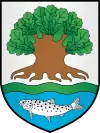Astravyets
Astravyets (Belarusian: Астравец, romanized: Astraviec, [astraˈvʲet͡s], Russian: Островец, tr. Ostrovets, IPA: [ɐstrɐˈvʲɛts], Lithuanian: Astravas, Polish: Ostrowiec) is a city in the Grodno Region of Belarus, an administrative center of the Astravyets District.
Astravyets
Астравец Островец | |
|---|---|
.jpg.webp) | |
 Flag  Coat of arms | |
 Astravyets | |
| Coordinates: 54°36′49″N 25°57′19″E | |
| Country | |
| Region | Grodno Region |
| District | Astravyets District |
| Population (2018) | |
| • Total | 10 878[1] |
| Time zone | UTC+2 (EET) |
| • Summer (DST) | UTC+3 (EEST) |
History
Within the Grand Duchy of Lithuania, Astravyets was part of Vilnius Voivodeship. In 1795, Astravyets was acquired by the Russian Empire in the course of the Third Partition of Poland.
From 1921 until 1939, Astravyets was part of the Second Polish Republic. In September 1939, the town was occupied by the Red Army and, on 14 November 1939, incorporated into the Byelorussian SSR.
From 27 June 1941 until 3 July 1944, Astravyets was occupied by Nazi Germany and administered as a part of the Generalbezirk Litauen of Reichskommissariat Ostland.
On 11 October 2011 an agreement was signed to build Belarus’ first nuclear power plant near the city, using two VVER reactors with active and passive safety systems. The first unit was planned to be completed by 2017.[2] In July 2012 a more detailed contract was agreed to build the two AES-2006 plants in for a cost of about 10 billion USD.[3] After some problems with the handling of a reactor pressure vessel, more recent estimates talk about a connection to the grid of the two blocks in 2020 .[4]
References
- The population of regions, districts and cities for January 1, 2018
- "Russia signs up to build NPP in Belarus". Nuclear Engineering International. 20 October 2011. Archived from the original on 2 April 2012. Retrieved 24 October 2011.
- "$10 billion construction contract signed for two AES 2006 Russian reactors in Belarus". I-Nuclear. 19 July 2012. Retrieved 8 August 2012.
- "Plans For New Reactors Worldwide". World Nuclear News. 2017-04-03. Retrieved 2019-12-12.
